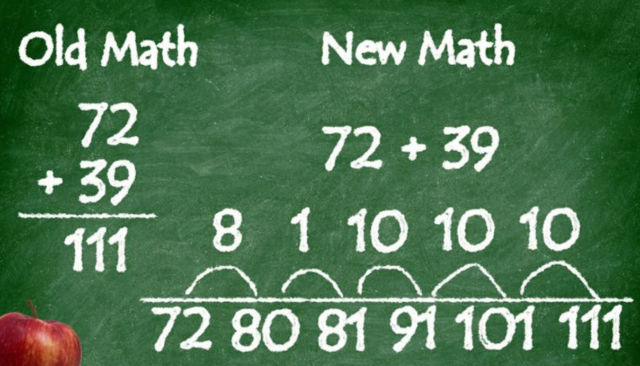
A student is showing his frustration at the example of the new math.
By now, you’ve probably seen some of the complaints on the internet about the “new math” being promoted by the Common Core Standards.
Many grade-school children have come home with math homework that is virtually indecipherable to their parents.
The goal behind the new math, it seems, is to encourage children to not just solve their basic arithmetic problems, but to understand the concepts underlying them.
But according to a fascinating article by educator Martin Cothran titled “Why Johnny Can’t Add,” this approach is wrong-headed, and may even be causing America’s students to regress. As Cothran points out, the “old math” worked just fine, and was the basis for many innovations in the past two centuries.
As a case in point, Cothran refers to the math education of his father, an aerospace engineer who worked on top-secret projects for the military and was on some of the early space shuttle launch teams.
In the article, Cothran includes some cool anecdotes about his father, including the following three:
* While he was rummaging in a closet at home, he came across a book titled The Nike Zeus Propulsion System authored by his father. When he showed it to him, his father quickly took it away and said nicely, “You’re not supposed to have that.” Cothran then explains, “The Nike Zeus was the nation’s first anti-ballistic missile.”
* While watching on TV the launching of Patriot missiles (to shoot down Iraqi SCUD rockets) during the first Gulf War, his father said, “Oh, that’s nothing. That technology is at least twenty years old. You should see what we have now.”
* While watching a news report on Iranian nuclear centrifuges, Cothran’s father remarked, “They must have somehow gotten the report I wrote on that.”
And where was Cothran’s father taught the math that paved the way for his career in aerospace engineering?
At a poor, one-room schoolhouse in the hills of South Carolina.
There, the students did not spend time learning why 10 + 5 = 15 or 9 – 7 = 2, and they had no fancy textbooks. According to Cothran’s father, “We just learned how to figure,” and left it at that. As was the experience of many of us, Cothran explains, “They memorized their addition and subtraction facts and their multiplication tables, and mastered long division through repeated drill and practice.” They simply memorized these things so that they would have a solid basis for the more conceptual math in later years. (And it’s interesting to note that the highest degree Cothran’s father obtained was a bachelor’s degree in ceramic engineering from Clemson University.)
 Now, with the new math, young students are being made to philosophize about 1+1 rather than simply memorizing that it equals 2. But as Cothran reminds us, the “new math” isn’t that new. He includes this other anecdote of his father:
Now, with the new math, young students are being made to philosophize about 1+1 rather than simply memorizing that it equals 2. But as Cothran reminds us, the “new math” isn’t that new. He includes this other anecdote of his father:
“I told my dad once about the kind of math they were doing in the early 1990s in schools in Kentucky where I lived. ‘That sounds like what they were doing in California in the 1950s,’ he said. ‘In fact, if you give me a report from one of my engineers and told me he was educated in California, I’ll tell you how old he is.’ These engineers, he said, would use computers to compute complex calculations, but would make basic mistakes that no good mathematician should make.”
Cothran argues that imposing conceptual education on basic arithmetic is not a sign of progress in education. “Arithmetic,” he writes, “is a tool—that is, a means, not an end. Arithmetic is not something you learn—it is something you should have learned.” In support of this contention, he quotes the great mathematician Alfred North Whitehead:
“It is a profoundly erroneous truism that we should cultivate the habit of thinking of what we are doing. The precise opposite is the case. Civilization advances by extending the number of important operations which we can perform without thinking about them.”
Cothran then concludes his article with this important reminder:
“The math education of my father’s day produced a whole generation of great scientists and engineers. They are the ones who sent men to the moon and who pioneered the computer revolution. They followed the great German scientists of the nineteenth century whose classical education enabled them to conduct the relativity and quantum revolutions in physics, and the development of genetics in biology.”
** I highly encourage you to read Cothran’s entire article in The Classical Teacher here.
Written by Daniel Lattier and published by Intellectual Takeout ~ April 22, 2016.
 FAIR USE NOTICE: This site contains copyrighted material the use of which has not always been specifically authorized by the copyright owner. We are making such material available in our efforts to advance understanding of environmental, political, human rights, economic, democracy, scientific, and social justice issues, etc. We believe this constitutes a ‘fair use’ of any such copyrighted material as provided for in section 107 of the US Copyright Law. In accordance with Title 17 U. S. C. Section 107, the material on this site is distributed without profit to those who have expressed a prior interest in receiving the included information for research and educational purposes. For more information go to: http://www.law.cornell.edu/uscode/17/107.shtml
FAIR USE NOTICE: This site contains copyrighted material the use of which has not always been specifically authorized by the copyright owner. We are making such material available in our efforts to advance understanding of environmental, political, human rights, economic, democracy, scientific, and social justice issues, etc. We believe this constitutes a ‘fair use’ of any such copyrighted material as provided for in section 107 of the US Copyright Law. In accordance with Title 17 U. S. C. Section 107, the material on this site is distributed without profit to those who have expressed a prior interest in receiving the included information for research and educational purposes. For more information go to: http://www.law.cornell.edu/uscode/17/107.shtml
